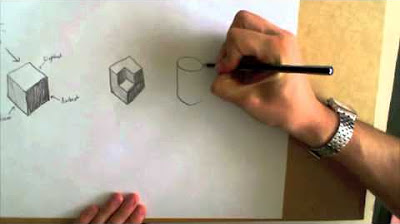How to Shade with PENCIL for BEGINNERS
Summary
TLDRIn this rapid fire art tutorial, Darlene teaches the fundamentals of adding depth to line drawings through shading. She covers pressure control, smooth shading techniques, and understanding light behavior. With practical exercises and insights on light reflection, core shadows, and highlights, viewers learn to create realistic shading on a sphere and an apple, enhancing their artistic skills without needing special tools.
Takeaways
- 🎨 Adding light and shadow to line drawings can create the illusion of form and depth, making the subject appear to jump off the page.
- ✏️ To improve shading, practice pressure control, smooth shading, and understanding light behavior.
- 📚 Pressure control involves creating a range of values from light to dark by varying the pressure applied to the pencil.
- 📐 Practice shading in a consistent manner across a page or within squares to develop muscle memory for consistent pressure.
- 🛠️ Any pencil can be used for realistic shading; special pencils are not necessary, even a burnt stick can serve as a pencil.
- 📏 To shade smoothly, avoid gaps between strokes and use a dull pencil tip or the side of the lead for broader strokes.
- 🤲 Use an overhand grip and pivot from the elbow and shoulder for longer, gap-free strokes when shading large areas.
- 💡 Understanding light is crucial; knowing the difference between direct light, reflected light, core shadows, and highlights can greatly affect the realism of artwork.
- 🌐 Light behavior can be studied using a simple sphere to understand how light and shadow patterns form on different surfaces.
- 🍎 When shading an object like an apple, start with a basic sketch, determine the light source, and then add cast shadows and core shadows considering the reflective properties of the surface.
- 🌟 Highlights are the brightest points on an object and can change position depending on the viewer's perspective; they indicate direct light reflection.
- 👀 Mid-tones are essential for creating the illusion of roundness on the light side of an object, and blending these with shadows helps to create a cohesive appearance.
Q & A
What is the main purpose of adding light and shadow to line drawings?
-Adding light and shadow to line drawings creates the illusion of form and depth, making the subject appear more lifelike and three-dimensional.
What are the three key practices Darlene suggests for better shading in art?
-The three key practices suggested are pressure control, shading smoothly, and understanding how light behaves.
How can one practice pressure control in shading?
-Pressure control can be practiced by shading from one end of a sketchbook to the other while increasing pressure to create a range of values, or by filling squares with varying values from dark to light.
Why is it important to maintain consistent pressure when shading?
-Maintaining consistent pressure ensures a smooth transition between values and helps develop muscle memory for realistic shading.
What does Darlene suggest as an alternative to using a pencil for shading?
-Darlene suggests using a burnt stick from the kitchen as an alternative to a pencil, emphasizing that any tool that can make light to dark marks can be used for shading.
How can one shade smoothly without leaving gaps between strokes?
-To shade smoothly, one should use a dull pencil tip or the side of the lead, and avoid using a writing grip, instead pivoting from the elbow and shoulder for longer strokes.
What are the two types of light that contribute to the appearance of shadows?
-The two types of light are direct light, which comes straight from the light source, and reflected light, which bounces off surfaces and illuminates shadowed areas.
What is the term used to describe the dark strip running along the boundary between the light and shadow sides of an object?
-The term is 'core shadow', which is most visible on reflective surfaces like white tables.
What is an occlusion shadow and how does it differ from a cast shadow?
-An occlusion shadow is the dark area where the object touches the surface it's resting on, while a cast shadow is the shadow the object casts on the surface, indicating the direction of the light source.
What are the three elements of the light side of a sphere that Darlene points out?
-The three elements are the core light, which is the area facing the light source directly; the highlight, which is the brightest point due to reflection of the light source; and the mid-tones, which are the darker values where the form curves away from the light.
How can one practice shading to improve their understanding of light behavior?
-One can practice by placing objects under a single light source, observing the patterns of light and shadow, and drawing the scene from different angles or even drawing from imagination based on the understanding of light behavior.
Outlines

Cette section est réservée aux utilisateurs payants. Améliorez votre compte pour accéder à cette section.
Améliorer maintenantMindmap

Cette section est réservée aux utilisateurs payants. Améliorez votre compte pour accéder à cette section.
Améliorer maintenantKeywords

Cette section est réservée aux utilisateurs payants. Améliorez votre compte pour accéder à cette section.
Améliorer maintenantHighlights

Cette section est réservée aux utilisateurs payants. Améliorez votre compte pour accéder à cette section.
Améliorer maintenantTranscripts

Cette section est réservée aux utilisateurs payants. Améliorez votre compte pour accéder à cette section.
Améliorer maintenantVoir Plus de Vidéos Connexes
5.0 / 5 (0 votes)






